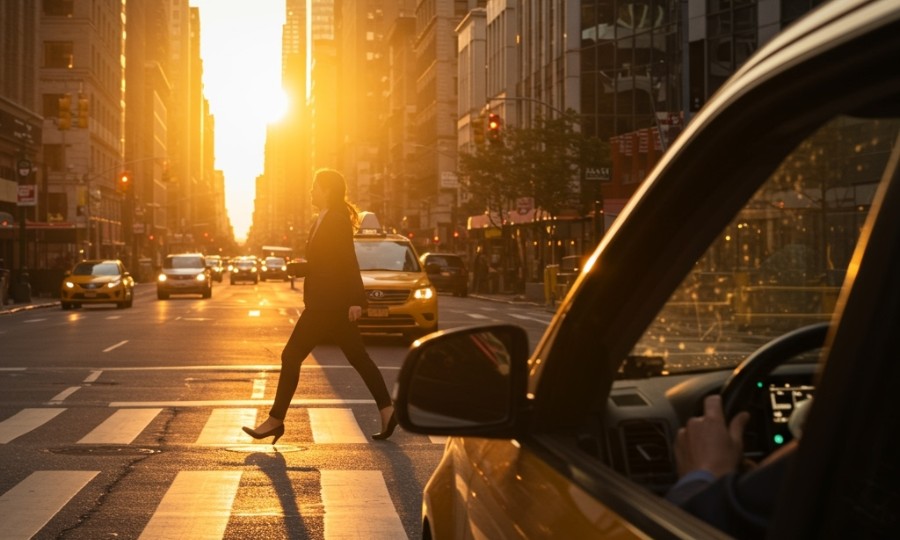
Ever felt that sudden lurch, that split-second panic, when a car veers a little too close as you’re crossing a busy New York City street? You know, that heart-in-your-throat moment? In a city that never sleeps, where pedestrians are constantly navigating a complex dance with vehicles, those near-misses aren’t just isolated incidents. They’re stark, often terrifying, reminders of a pervasive, insidious threat: distracted driving. It’s a problem that continues to endanger countless lives, making our vibrant sidewalks feel just a little less safe.
The Alarming Reality of Distracted Driving in NYC
When we talk about distracted driving, most of us immediately picture someone texting behind the wheel, right? While that’s certainly a major culprit, the truth is, it’s so much broader than just a phone screen. Distracted driving encompasses any activity that takes a driver’s attention away from the primary task of driving. This could mean anything from fiddling with the GPS, eating a bagel, applying makeup, or even just being deeply engrossed in a conversation with a passenger. The National Highway Traffic Safety Administration (NHTSA) consistently reports that distracted driving claimed 3,308 lives in 2022 alone across the U.S., and while New York City has made strides, its dense population and unique urban environment present particular challenges.
Think about it: NYC streets are a constant ballet of yellow cabs, delivery trucks, cyclists, scooters, and thousands upon thousands of pedestrians. We’re talking about intricate intersections, constant stop-and-go traffic, and a dynamic streetscape that demands unwavering focus. A driver who glances down at their phone for just two seconds at 30 mph has effectively driven a football field blind. In a city where a child might dart out, or a delivery bike might appear from nowhere, that’s an eternity. Are we truly grasping the full impact of these momentary lapses?
Beyond the Phone: Understanding All Forms of Distraction
It’s easy to dismiss other distractions as less dangerous than texting, but that simply isn’t the case. While New York State law strictly prohibits the use of handheld electronic devices while driving (and you’ll face fines and points if caught, as per the Department of Motor Vehicles), the cognitive distraction of even hands-free devices is well-documented. Your brain simply can’t process complex driving tasks and an engaging phone conversation with the same efficiency. You might be physically holding the wheel, but mentally, you’re elsewhere. This ‘mind wandering’ is incredibly dangerous, especially in an environment like NYC.
The Human Cost: Real-World Scenarios
To truly understand the stakes, let’s consider a few all-too-common scenarios:
- The Delivery Dilemma: Imagine a delivery driver, focused on hitting their next drop-off target, glances at their phone for directions or to confirm an order. As they turn onto a cross street, a pedestrian—perhaps a tourist marveling at the architecture—steps into the crosswalk, assuming the driver sees them. That brief, seemingly harmless glance means the driver misses the pedestrian entirely, leading to a devastating collision. We know this feels incredibly frustrating for everyone involved, but these moments of inattention have irreversible consequences.
- The Parent’s Predicament: A parent is driving their kids home from school. A child in the backseat suddenly asks for something, pulling the parent’s attention away for a second or two. During that brief moment, a pedestrian, perhaps an elderly individual or someone with reduced mobility, starts to cross the street with the light. The driver, momentarily distracted by their child’s needs, doesn’t react in time, leading to a tragic accident.
- The Commuter’s Conversation: Picture a busy commuter, engrossed in a work call (even hands-free), approaching a complex intersection with changing lights and multiple pedestrian flows. Their mind is on the meeting, not the evolving traffic situation. They might miss a pedestrian starting to cross just as the light changes, or fail to yield to someone in a crosswalk, simply because their cognitive load is elsewhere. (You’d be surprised how quickly a situation can change in a blink.)
These aren’t abstract concepts; they’re daily realities on our streets. The emotional toll, the physical injuries, and the profound disruption to lives are very, very real.
NYC’s Fight for Safer Streets: Vision Zero and Beyond
New York City has been at the forefront of tackling traffic safety through its ambitious Vision Zero initiative, launched in 2014. The core idea is simple yet revolutionary: traffic fatalities and serious injuries are preventable, not inevitable. Vision Zero has led to significant changes, including redesigned streets, lower speed limits, increased enforcement of dangerous driving behaviors (like speeding and failing to yield), and robust public awareness campaigns. The city’s Department of Transportation (DOT) actively works to make our streets safer for pedestrians, cyclists, and drivers alike.
Law enforcement plays a critical role too, issuing summonses for distracted driving and other hazardous behaviors. But here’s the thing: while enforcement and infrastructure improvements are vital, they can only go so far without a fundamental shift in driver behavior. Vision Zero relies on all of us understanding and accepting our shared responsibility to keep each other safe. But is enforcement enough without a shift in driver mindset?
Your Role in Fostering a Culture of Awareness
The truth is, we all have a part to play in reducing distracted driving and enhancing pedestrian safety in NYC. It’s not just about what the city or law enforcement does; it’s about our individual choices every single day.
For Drivers:
- Put It Away: The simplest and most effective solution is to put your phone away – out of sight, out of mind. Use your car’s ‘Do Not Disturb’ mode.
- Plan Ahead: Set your GPS, adjust your music, or make that important call before you even put the car in drive.
- Stay Present: Be aware of your surroundings, especially in high-pedestrian areas. Make eye contact with pedestrians and cyclists. Assume they might not see you.
For Pedestrians:
- Stay Alert: While drivers bear the primary responsibility, you also have a role. Avoid walking with headphones at full volume or staring at your phone while crossing the street.
- Make Eye Contact: Before stepping into a crosswalk, try to make eye contact with drivers. Don’t assume they see you, even if you have the right-of-way.
- Be Visible: Especially at night, wear bright clothing and consider carrying a light.
Ultimately, making our streets safer isn’t about blaming; it’s about shared vigilance and a collective commitment to focus. It’s a two-way street, isn’t it? We can’t afford to be complacent. Let’s pledge to drive and walk with purpose, ensuring that every journey in our incredible city is a safe one for everyone.
Free Case Consultation
Injured in an accident? Contact Rosenberg, Minc, Falkoff & Wolff for a free and confidential case review with an experienced NYC personal injury attorney.


